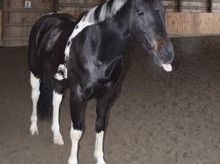I found an avian vet! Although not very experienced with pet hens, at least she was willing to see Buffy.
Poor Buffy, both eyes are crusted with yellow mucus. She looks miserable. The vet gave her a thorough exam and, thank goodness, except for a swollen comb and sinuses, Buffy doesn’t have any symptoms of respiratory disease.
Dr. Rittle believes that Buffy has avian conjunctivitis, a disease caused by mycoplasm (a unique form of bacteria). It is found in poultry flocks, but also in wild house finches. Because I have two other hens, Ginger and Petunia, who had swollen eyes that healed with antibacterial eye ointment, this diagnosis sounds logical. I could have had blood work done to confirm this, but it would have added $50 to my vet bill that had already cost $114, and so I opted out. If, however, Buffy doesn’t respond to the medication, or another hen becomes ill with worse symptoms, I’ll be right back to see Dr. Rittle.
Conjunctivitis is spread by direct contact, so it is easier to control than an airborne illness. I have a dispenser of hand sanitizer in the barn, which I will use frequently. Buffy is isolated in a dog crate. I will be bagging and throwing out dirty shavings, not composting them. Hopefully, Buffy will be the last hen with this disease.
I don’t know where it came from. Perhaps Prudence was a carrier – a perfectly healthy looking bird can spread it. Perhaps some infected house finches had contact with my flock. You can really understand why farmers need to practice biosecurity, and the risks (though I think worth it) that free-range farmers take.
